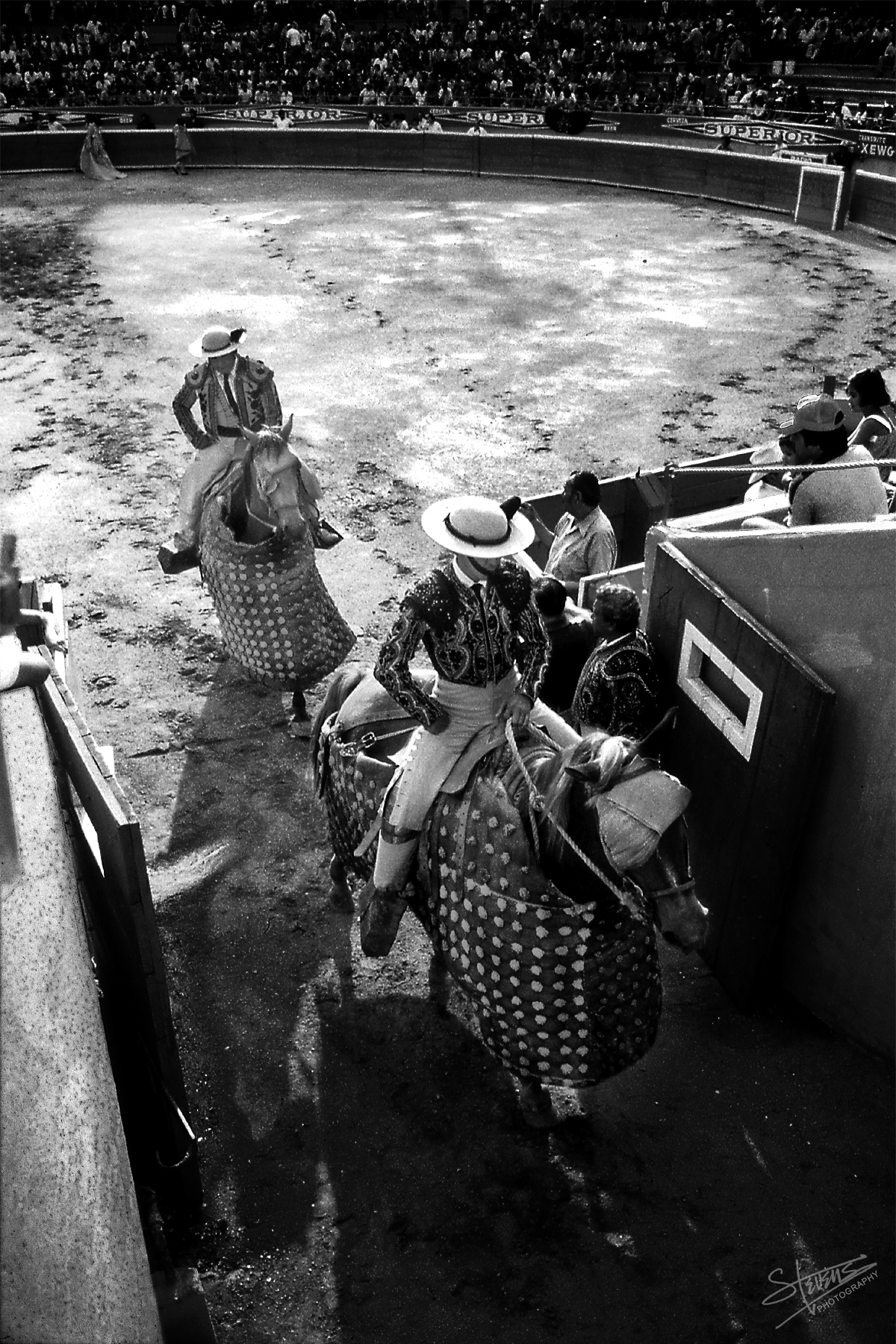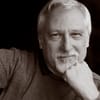Bullring: Juárez-1975
Ceremony Carved in Sunlight

I shot this photograph back in 1975 with my very first 35 mm — an all-manual Fujica ST801 without a light meter, built-in or otherwise. I remember standing at Plaza Monumentál in Juárez, wide-eyed at my only-ever bullfight, hand-holding that 50 mm lens and trusting whatever instincts I’d picked up about seeing light. Most of the action felt too far off for my lens, but here — at the moment the picadores were led into the ring — everything settled into place, as if some ancient rhythm had just come into focus.
These were the men who drew first blood. Mounted on thick-necked horses wrapped in polka-dotted protective cloaks, the picadores were blunt force before flourish — lancing the bull’s shoulder to weaken its neck, make him lower his head. On the surface, it’s brutality. But inside the plaza de toros, it was ritual — measured, symbolic, and, in its own strange way, honorable.
Looking through the viewfinder, I saw the arena not as a stadium, but as a stage. The men in their traje de luces — those ornate “suits of light” — sat poised and unmoving. They didn’t fidget or talk. They waited — for their role in a centuries-old sequence of performance and peril. This was not sport. This was ceremony, dressed in color and danger.
I knew little of it then. I was twenty-something, nervous, still learning to trust what my eyes were telling me. I had no meter, just what I’d picked up from magazines and scraps of advice. A week earlier, I’d been told about the Sunny 16 Rule: “One over the ASA film speed at f/16 in bright daylight.” It sounded like a spell. I muttered it under my breath, unsure whether I was invoking confidence or just hiding uncertainty. I set the shutter, dialed in the aperture, and hoped.
The shadows fell long across the sand, cutting the arena into triangles and fractured diagonals. The dirt was damp, scarred with hoofprints from the previous fight. Behind the riders, the grandstands melted into silhouette, a few faces visible, others hidden behind glinting sunglasses and cigarette smoke. Above them, a banner flapped lazily — “SUPERIOR,” it read, almost too faint to make out, but there just the same, as if offering silent judgment.
This was the frame. The only one that worked.
The horses stood like statues. The picadores sat tall in the saddle but with the same solemnity you might find in a procession. There is a choreography to the corrida, and this was its prologue. The bull had not yet entered, but you could feel the coiled tension of the ring, like a breath waiting to be released.
I learned later that the tercio de varas — the stage of the fight where the picadores work — serves a dual purpose. Yes, it weakens the bull physically, but it also reveals his nature. Is he brave? Does he charge head-on or favor one side? Does he lower his head in rage or raise it in confusion? The matador will need to know these things. The picador finds them out. Not by observation, but by provocation.
What I saw that day in Juárez squared the circle for me. As a boy in high school, before turning over to sleep, I would watch bullfighting on Sunday nights on my little black and white TV, and marvel at the bravery of the matadors and their skill in passing the cape before the bull’s eyes, mesmerizing him.
Even now, years later, I hesitate to say I understand bullfighting. You don’t understand a ritual like that, not really. You witness it. You absorb it. You wrestle with it later, over time, in memory. There’s savagery, yes. But there’s also elegance, precision, and a kind of ancestral logic that defies modern clarity.
What I know is this: I stood there, camera in hand, on the outer edge of something I didn’t quite grasp. And for a brief second, everything aligned. The light, the posture of the riders as the exited the arena, the tension in the horses’ legs, the diagonal cuts of shadow across the sand. I pressed the shutter. One click. The only frame that truly held something.
It wasn’t the moment of greatest action. No goring, no charge, no blur of cape. It was the pause before — all potential, all breath held tight. The kind of stillness that speaks louder than movement. A quiet before the charge.
That photo taught me more about composition, patience, and trust than any manual ever could. No autofocus, no motor drive, no forgiveness. Just me, the camera, and a gut-level gamble on exposure.
I look at it now, nearly fifty years later, and I remember the nerves in my hands. I remember not knowing if I got the shot. I remember walking out of that arena both overwhelmed and transformed, not because I agreed with the spectacle — and I did — but because I had seen something older than me, older than photography, older maybe than reason.
That frame still holds something I can’t quite name.
But I know it helped to shape the way I see.
Have you encountered a place whose history felt heavier than its walls?
— Lawrence

Thanks for reading Still Stories! Subscribe for free to receive new posts and support my work.

